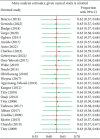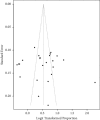Exploring the Prevalence and Components of Metabolic Syndrome in Sub-Saharan African Type 2 Diabetes Mellitus Patients: A Systematic Review and Meta-Analysis
- PMID: 38410415
- PMCID: PMC10896656
- DOI: 10.1155/2024/1240457
Exploring the Prevalence and Components of Metabolic Syndrome in Sub-Saharan African Type 2 Diabetes Mellitus Patients: A Systematic Review and Meta-Analysis
Abstract
Background: Type 2 diabetes mellitus and metabolic syndrome represent two closely intertwined public health challenges that have reached alarming epidemic proportions in low- and middle-income countries, particularly in sub-Saharan Africa. Therefore, the current study aimed to determine the weighted pooled prevalence of metabolic syndrome and its components among individuals with type 2 diabetes mellitus in sub-Saharan Africa as defined by the 2004 National Cholesterol Education Program-Adult Treatment Panel (NCEP-ATP III 2004) and/or the International Diabetes Federation (IDF) criteria.
Methods: A systematic search was conducted to retrieve studies published in the English language on the prevalence of metabolic syndrome among type 2 diabetic individuals in sub-Saharan Africa. Searches were carried out in PubMed, Embase, Scopus, Google Scholar, African Index Medicus, and African Journal Online from their inception until July 31, 2023. A random-effects model was employed to estimate the weighted pooled prevalence of metabolic syndrome in sub-Saharan Africa. Evidence of between-study variance attributed to heterogeneity was assessed using Cochran's Q statistic and the I2 statistic. The Joanna Briggs Institute quality appraisal criteria were used to evaluate the methodological quality of the included studies. The summary estimates were presented with forest plots and tables. Publication bias was checked with the funnel plot and Egger's regression test.
Results: Overall, 1421 articles were identified and evaluated using the Preferred Reporting Items for Systematic Reviews and Meta-analyses (PRISMA) guidelines, and 30 studies that met the inclusion criteria were included in the final analysis. The weighted pooled prevalence of metabolic syndrome among individuals with type 2 diabetes mellitus in sub-Saharan Africa was 63.1% (95% CI: 57.9-68.1) when using the NCEP-ATP III 2004 criteria and 60.8% (95% CI: 50.7-70.0) when using the IDF criteria. Subgroup analysis, using NCEP-ATP III 2004 and IDF criteria, revealed higher weighted pooled prevalence among females: 73.5% (95% CI: 67.4-79.5), 71.6% (95% CI: 60.2-82.9), compared to males: 50.5% (95% CI: 43.8-57.2), 44.5% (95% CI: 34.2-54.8), respectively. Central obesity was the most prevalent component of metabolic syndrome, with a pooled prevalence of 55.9% and 61.6% using NCEP-ATP III 2004 and IDF criteria, respectively. There was no statistical evidence of publication bias in both the NCEP-ATP III 2004 and IDF pooled estimates.
Conclusions: The findings underscore the alarming prevalence of metabolic syndrome among individuals with type 2 diabetes mellitus in sub-Saharan Africa. Therefore, it is essential to promote lifestyle modifications, such as regular exercise and balanced diets, prioritize routine obesity screenings, and implement early interventions and robust public health measures to mitigate the risks associated with central obesity.
Copyright © 2024 Nelson Musilanga et al.
Conflict of interest statement
The authors declare that they have no conflicts of interest.
Figures








Similar articles
-
Prevalence of vision impairment among patients with diabetes mellitus in sub-Saharan Africa: A systematic review and meta-analysis.PLoS One. 2025 Jun 24;20(6):e0326176. doi: 10.1371/journal.pone.0326176. eCollection 2025. PLoS One. 2025. PMID: 40554578 Free PMC article.
-
Prevalence and Genotype Distribution of High-Risk Human Papillomavirus Infection Among Sub-Saharan African Women: A Systematic Review and Meta-Analysis.Front Public Health. 2022 Jul 8;10:890880. doi: 10.3389/fpubh.2022.890880. eCollection 2022. Front Public Health. 2022. PMID: 35875040 Free PMC article.
-
Prevalence and determinants of adolescent pregnancy in Africa: a systematic review and Meta-analysis.Reprod Health. 2018 Nov 29;15(1):195. doi: 10.1186/s12978-018-0640-2. Reprod Health. 2018. PMID: 30497509 Free PMC article.
-
Participant views and experiences of participating in HIV research in sub-Saharan Africa: a qualitative systematic review.JBI Database System Rev Implement Rep. 2015 Jun 12;13(5):330-420. doi: 10.11124/jbisrir-2015-2051. JBI Database System Rev Implement Rep. 2015. PMID: 26455613
-
Prevalence of chronic kidney diseases among people living with HIV in Ethiopia: a systematic review and meta-analysis.BMC Infect Dis. 2025 Jul 1;25(1):850. doi: 10.1186/s12879-025-11212-x. BMC Infect Dis. 2025. PMID: 40597745 Free PMC article.
Cited by
-
Comprehension of gut microbiota and microRNAs may contribute to the development of innovative treatment tactics against metabolic disorders and psychiatric disorders.Int J Physiol Pathophysiol Pharmacol. 2024 Dec 25;16(6):111-125. doi: 10.62347/WAZH2090. eCollection 2024. Int J Physiol Pathophysiol Pharmacol. 2024. PMID: 39850247 Free PMC article. Review.
-
The association between alcohol and metabolic syndrome: a systematic review and meta-analysis.Diabetol Metab Syndr. 2025 Jul 2;17(1):250. doi: 10.1186/s13098-025-01815-4. Diabetol Metab Syndr. 2025. PMID: 40604905 Free PMC article.
-
Influence of Age and Sex on the Clinical Profile of Metabolic Syndrome in Diabetic Patients.Cureus. 2025 Jul 20;17(7):e88376. doi: 10.7759/cureus.88376. eCollection 2025 Jul. Cureus. 2025. PMID: 40837939 Free PMC article.
References
-
- National Cholesterol Education Program. Third report of the national cholesterol education Program (NCEP) expert Panel on detection, evaluation, and treatment of high blood cholesterol in adults (adult treatment Panel III) final report. Circulation . 2002;106(25):3143–3421. - PubMed
-
- Zimmet P., Alberti G., Shaw J. A new IDF worldwide definition of the metabolic syndrome: of the metabolic syndrome: the rationale and the results. Diabetes Voice . 2005;50(3):31–33.
Publication types
MeSH terms
LinkOut - more resources
Full Text Sources
Medical
Miscellaneous

